
LinkedIn is now one of the primary platforms where you can find your buyers. So, who inhabits this ocean of opportunities? Let’s find out.

Intro – How Popular Is LinkedIn?
According to the latest data published by LinkedIn in 2025, the number of users has reached one billion. You can see a map below showing where most of the users are located. As we can see, the primary location is the United States, with a whopping 220 million LinkedIn users. This makes LinkedIn a universal tool where you can find specialists for remote work in any location as well as clients in local markets.
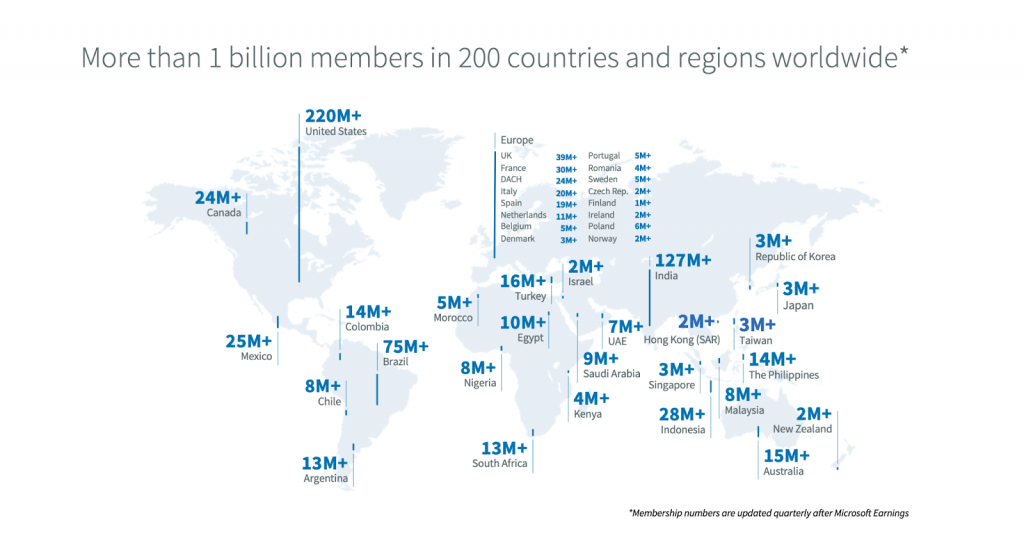
LinkedIn is also adapted to 36 different languages, making it easier for the social network to operate globally.
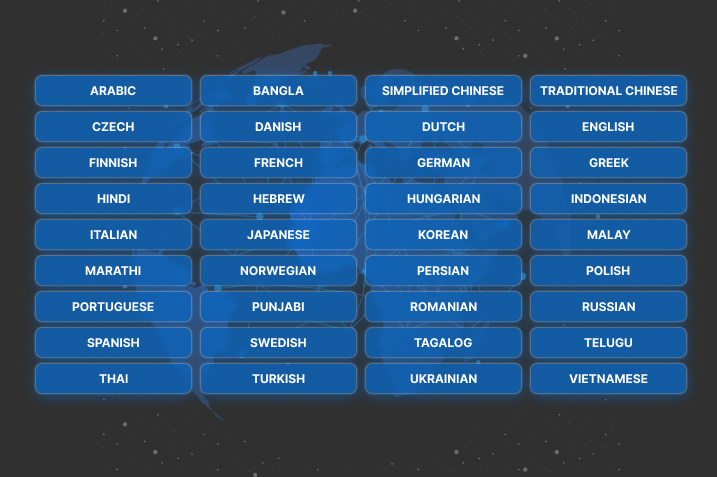
LinkedIn’s Popularity in the Social Media Landscape
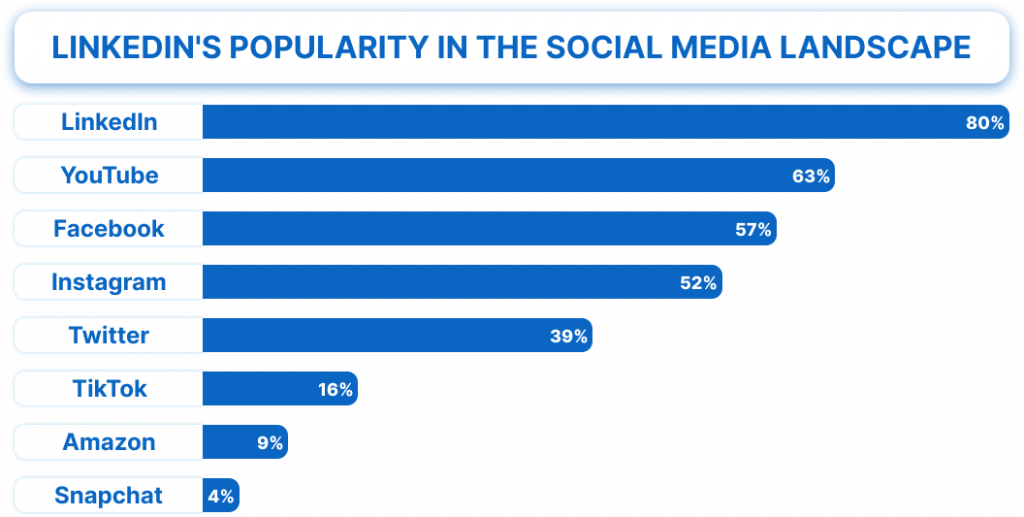
Source: eMarketer/ Insider Intelligence
How popular is LinkedIn compared to other social networks, you might ask? It depends on your goals.
However, if you are a marketer promoting IT products or looking for clients in the B2B sector, LinkedIn is the main platform you should be working on.
According to statistics, 80% of B2B clients use LinkedIn. Therefore, according to an eMarketer survey, this is where you should focus your main efforts to find clients.
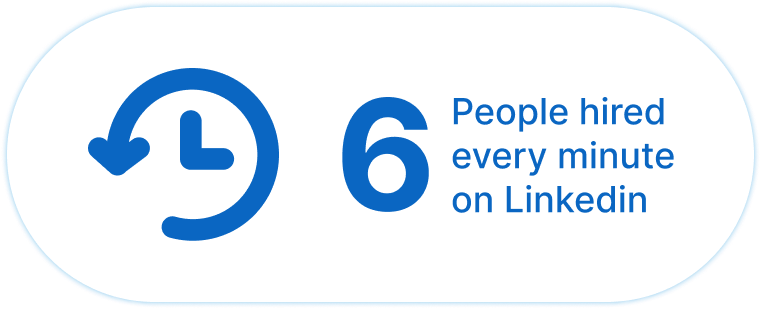
According to LinkedIn’s official statistics, six people are hired or find jobs every minute through LinkedIn. Therefore, another spectrum of goals you can achieve with LinkedIn is hiring and job searching.

How many users are on LinkedIn?
Below, you can see LinkedIn’s statistics on the number of users from 2023 to 2024. Additionally, there are 67 million companies and 134,000 educational institutions represented on the platform.

The infographic below illustrates growth trends. Over its 20-year existence since 2003, LinkedIn has grown from 1 million to one billion users.
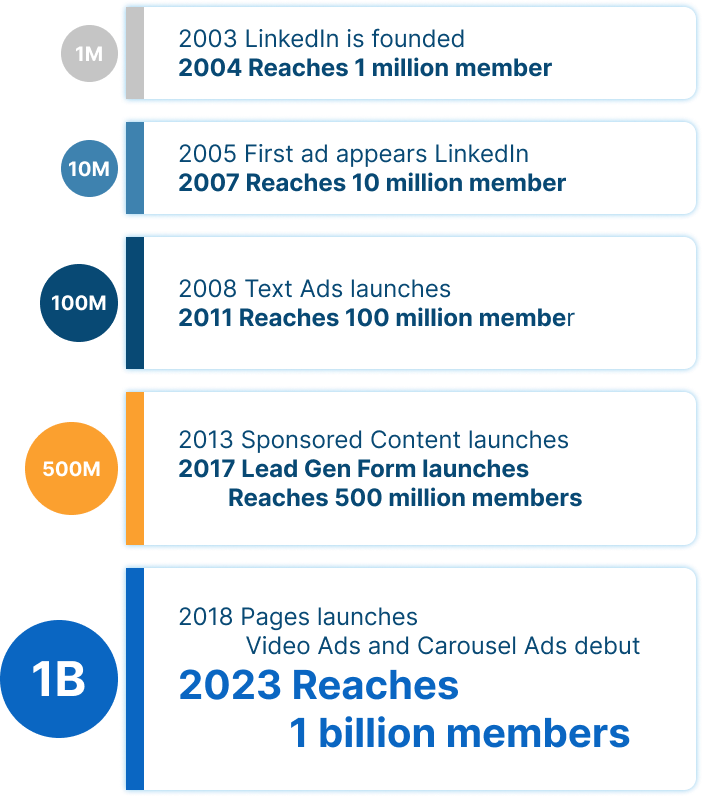
LinkedIn monthly active users
LinkedIn has approximately 310 million monthly active users according to recent statistics. However, LinkedIn does not explicitly list this information, so we can only rely on online articles for this data.
According to the trusted source Statista, nearly 50% of people visit LinkedIn monthly, while nearly three times fewer people use the app daily.
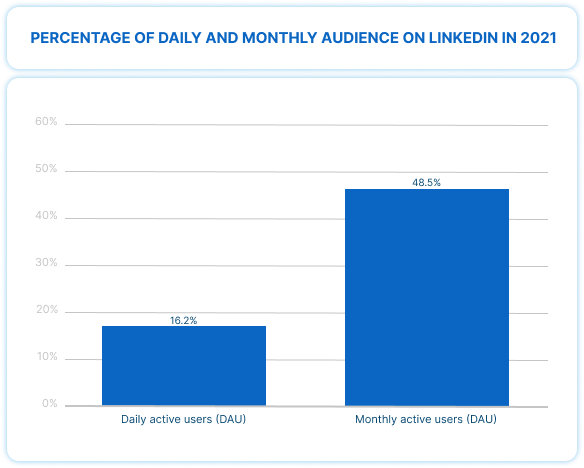
Additionally, according to official LinkedIn statistics, 65 million people search for jobs weekly on the social network. If we extrapolate this to a monthly figure, it amounts to around 260 million people using this social media.

LinkedIn daily active users and engagement ratio
Approximately 134.5 million users actively use LinkedIn each day
To determine the engagement ratio, we compare daily active users (DAUs) to monthly active users (MAUs):
Engagement Ratio (DAU/MAU)=(134.5 million/310 million)
Engagement Ratio≈0.434
This means that approximately 43.4% of LinkedIn’s monthly active users are engaged on a daily basis.
For a broader context, let’s compare LinkedIn’s engagement ratio to other popular social media platforms:
- Facebook: Historically, Facebook has had a DAU/MAU ratio of around 66%.
- Twitter: Twitter’s DAU/MAU ratio is typically around 40%.
- Instagram: Instagram often sees a DAU/MAU ratio of about 50%.
So, LinkedIn’s engagement ratio of 43.4% indicates a moderate level of daily user engagement compared to other social media platforms. While it may not be as high as Facebook, it is comparable to Twitter and falls within a reasonable range for professional networking sites.
Download Linked Helper 2
and get 14-day free trial right now
DOWNLOADIf you are not yet in our list of users, then join.
We give you a trial version to start your experience with our LinkedIn tool.
LinkedIn age demographics
The average age of a LinkedIn user
The average age of LinkedIn users is approximately 28.8 years.
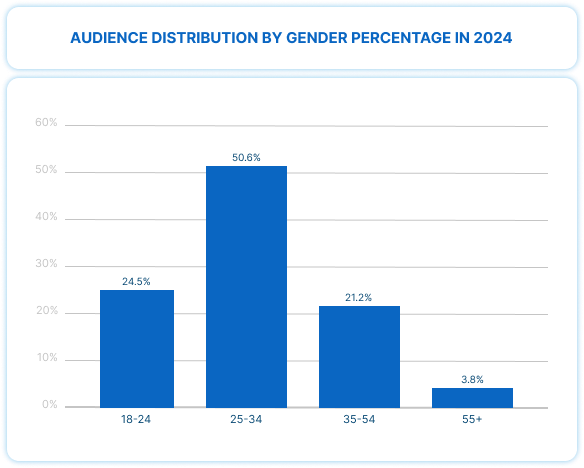
LinkedIn’s user base shows a diverse range of ages, with significant concentrations in the following categories:
- Millennials (25-34 years old): Approximately 50% of LinkedIn users fall into this age group, representing both Millennials and younger Boomers.
- Young Adults (18-24 years old): 24.5% of LinkedIn users are in this age range, indicating they are just starting their careers.
- Experienced Professionals (35 years and older): Around 24% -This age group includes a significant portion of seasoned professionals, showcasing the platform’s appeal to a broad range of career stages.
LinkedIn’s user base is predominantly made up of Millennials and experienced professionals, reflecting a platform that caters to both emerging and established talent. This suggests a stable and growing user base with a focus on career development and networking.
Unlike more casual social platforms, LinkedIn’s audience is more career-focused and includes a higher percentage of older professionals. This contrasts with platforms like Instagram or TikTok, which have younger user bases.
LinkedIn user statistics
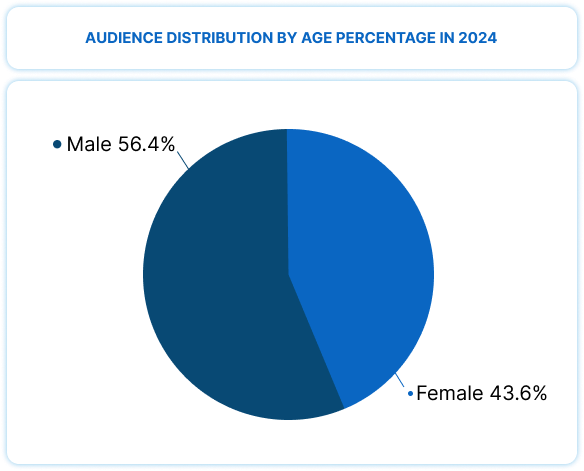
LinkedIn’s gender distribution shows a slight male majority (56.4%) compared to female users (43.6%). This distribution is similar to Facebook, which also has a near-equal gender ratio with a slight male majority. Instagram displays a more balanced gender distribution, while Twitter has a significant male majority, and TikTok has a female majority.
Overall, LinkedIn’s gender demographics reflect a balanced user base, comparable to major social platforms, indicating a diverse and inclusive professional networking environment.
Audience locations
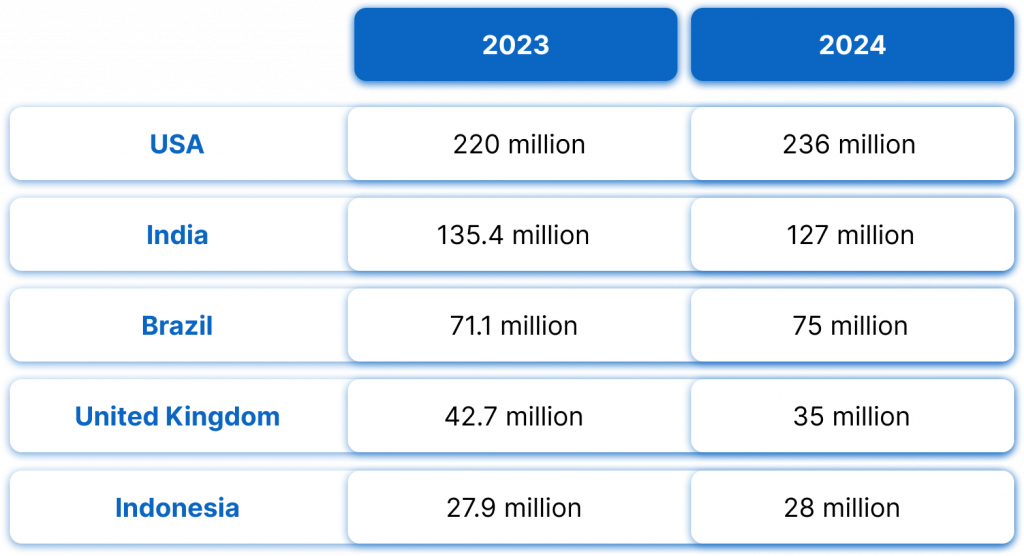
LinkedIn is also widely used in France with 30 million users. The DACH region (Germany, Austria, Switzerland) and Canada each have 24 million users, and Mexico has 25 million users. Just imagine the vast regional markets you can access.
LinkedIn influential user base

According to LinkedIn statistics, out of 1 billion users:
- 180 million are senior influencers
These are experienced professionals who have significant influence in their industries. They often share insights and drive conversations within their fields.
- Examples:
- 63 million are decision-makers in companies
These individuals hold key positions within companies and have the authority to make strategic decisions, such as CEOs, COOs, and other executives.
- 10 million are C-level executives
These are top-level executives who hold C-suite positions such as CTO, COO, and CMO, responsible for overseeing various aspects of the business.
Institutional Investors
Institutional investors are increasingly turning to LinkedIn as a key resource for staying informed about financial topics, surpassing their reliance on specialist financial publications. This shift highlights the growing influence and accessibility of LinkedIn in providing timely and relevant financial information.
Additionally, these investors are dedicating a significant amount of time to engage deeply with content on LinkedIn, often spending between 15 to 30 minutes on a single piece. This behavior underscores the importance of producing high-quality, insightful content on the platform that can capture and hold their attention.

LinkedIn audience insights
LinkedIn is a platform for engaging with influential and high-impact users. By leveraging LinkedIn’s network, brands like BlackLine can connect with a diverse group of professionals, including those in finance and accounting, who have the potential to become strong advocates for the brand. These power users can significantly amplify the brand’s message, reaching a broader audience. BlackLine’s success in growing its LinkedIn following to over 10,000 demonstrates how effectively engaging with the right audience on this platform can enhance brand visibility and influence key decision-makers.

Education
The level of education can significantly impact the quality of hiring on LinkedIn. Here are some key insights based on available data:
- Bachelor’s Degree: 33% of LinkedIn users hold a bachelor’s degree, making it the most common educational level among professionals on the platform.
- Secondary Education: Only 2% of users have a secondary education, indicating a higher concentration of highly educated professionals.
This means you can share specialized and complex content with a highly educated audience.
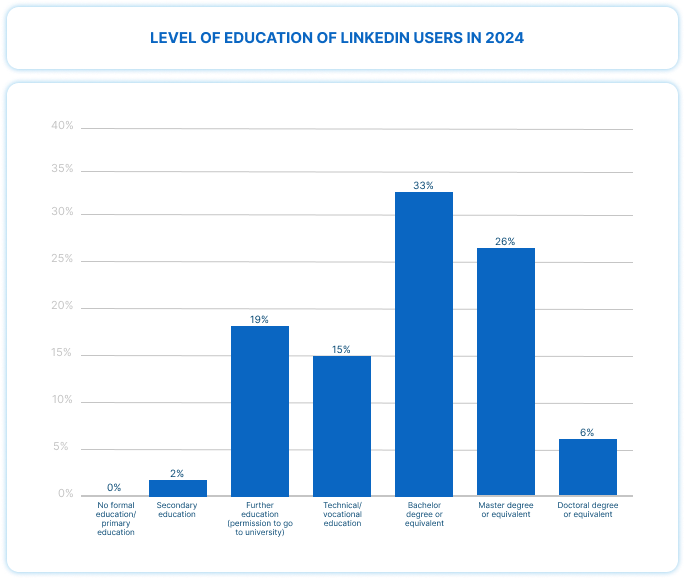
Skills Utilization
Almost half of LinkedIn users utilize the platform’s skill features to find employees, ensuring that job matches are highly relevant to employers’ needs.
Open to Work Usage

There are 28 million users who explicitly indicate they are open to work. This feature can be filtered through a Recruiter subscription, but our article reveals methods to find such candidates using a free subscription.
Collaborative Articles

One unique LinkedIn tool is collaboration articles. More than 12 million users leverage this method to share experiences and create valuable content.
High Skill Matches
According to LinkedIn statistics, 67% of hires made through the platform have high professional skills. This means profile descriptions often align well with the actual skills of the users.

All in all: How businesses can target right users
In studying quotes and demographics, it becomes clear how important it is to choose the right niche on LinkedIn, as it is a treasure trove of some of the most influential people in various industries.
To select only the right leads and niche, you can use LinkedIn filters. Filters are enhanced in paid solutions, but even a basic profile allows you to search by position, location, industry, and Boolean search. In Sales Navigator, the filters are much more targeted, and you can study the difference in our article.
Additional filters in automation tools: if you use automation to reach your audience, you should check how well the tool can sort the list before launching a campaign, as this affects the results.
For example, Linked Helper has a built-in filter for finding “open to work” from the basic search, though this is usually only available in the Recruiter subscription. It also allows sorting by headlines and removing unnecessary people from campaigns.
Searching by groups: sometimes you can find your target demographic in LinkedIn groups based on interests—for example, groups for senior management, marketers, or tech specialists. The group filter is available in Sales Navigator and allows you to find people only if you also belong to the group.
Interaction with posts: you can find targets among those who like the content and those who comment. Reaction to content is an important indicator of your audience. Therefore, this filter can be applied in LinkedIn Helper.
To launch a campaign, you can study the ABM strategy we recently described in our blog.